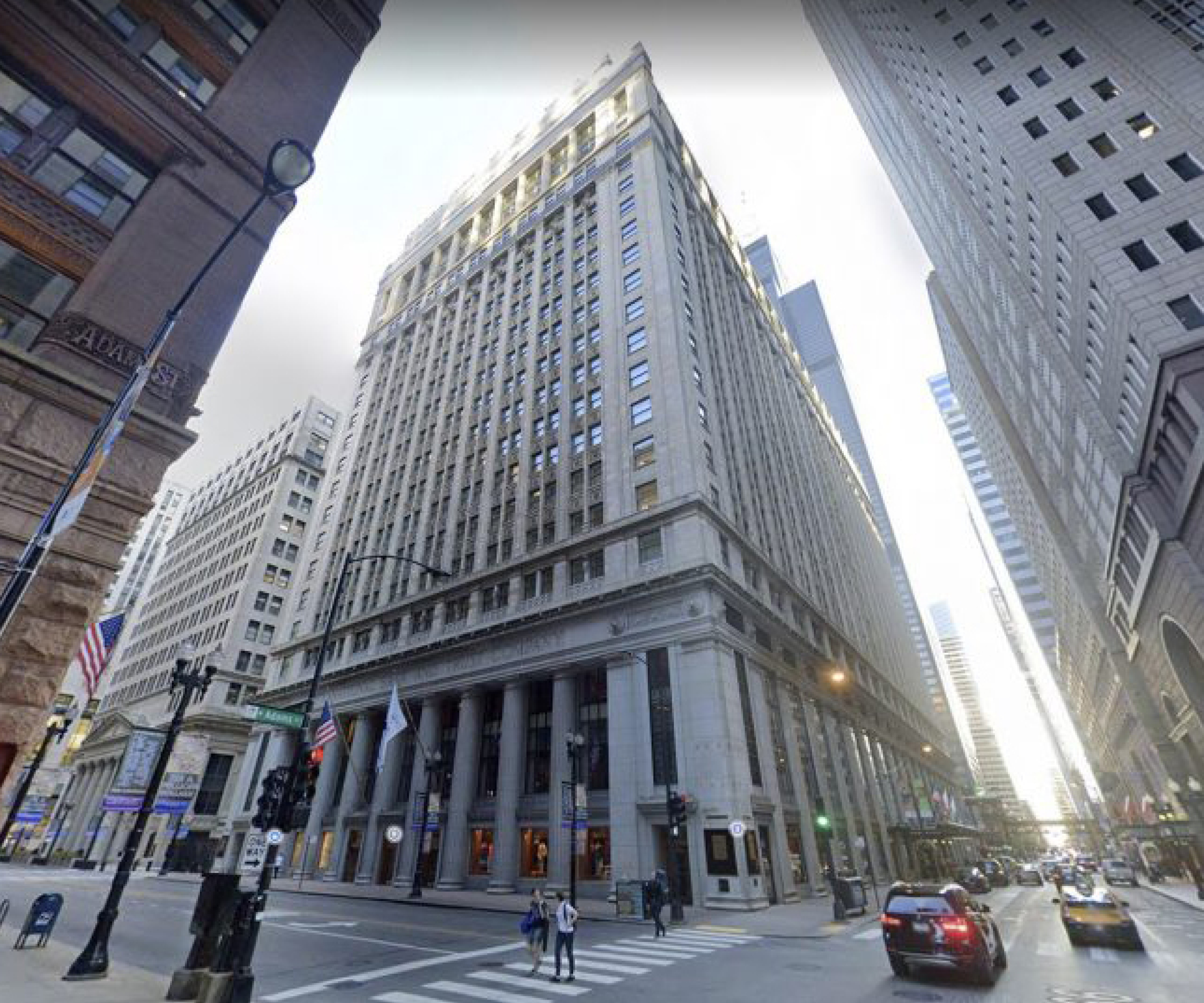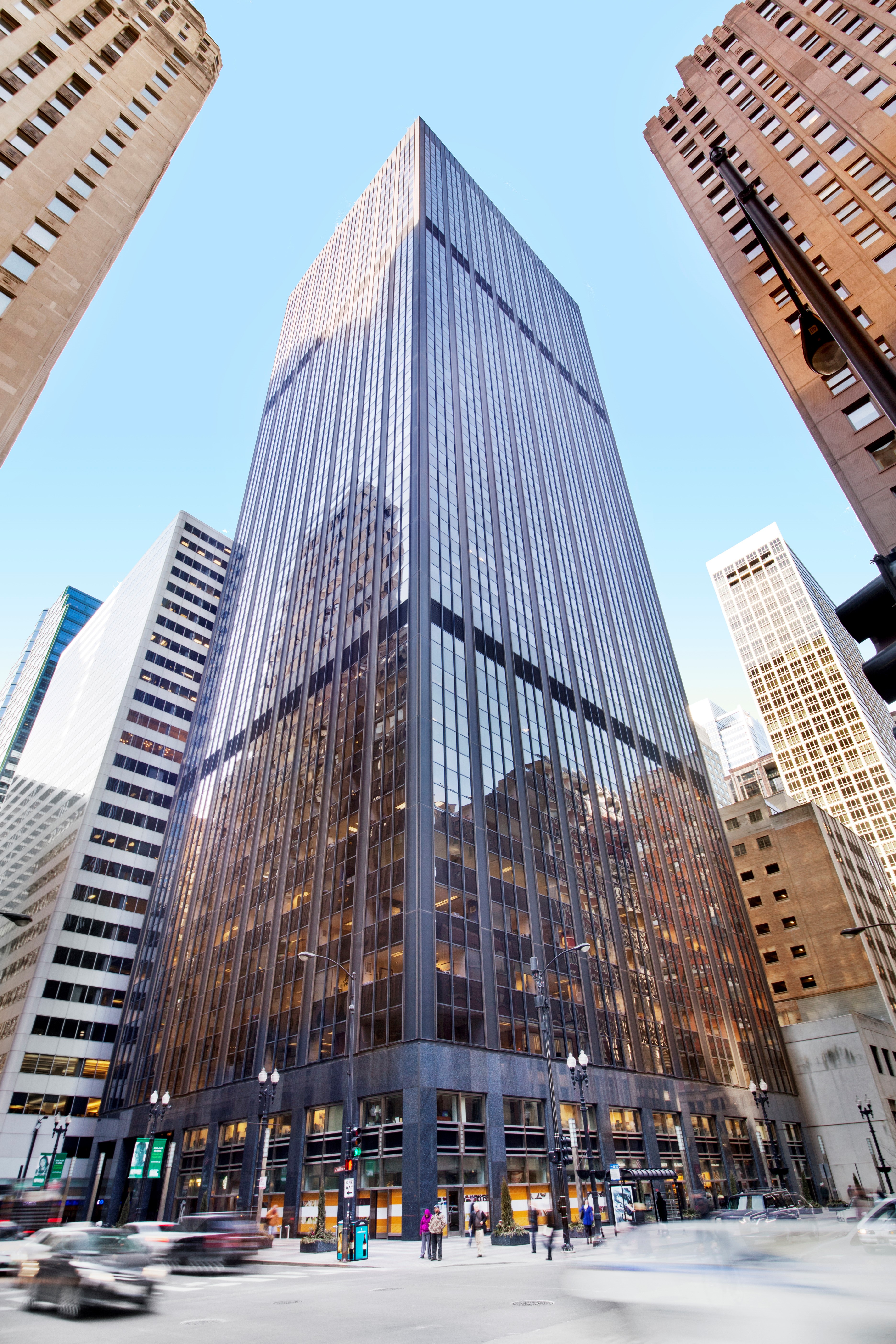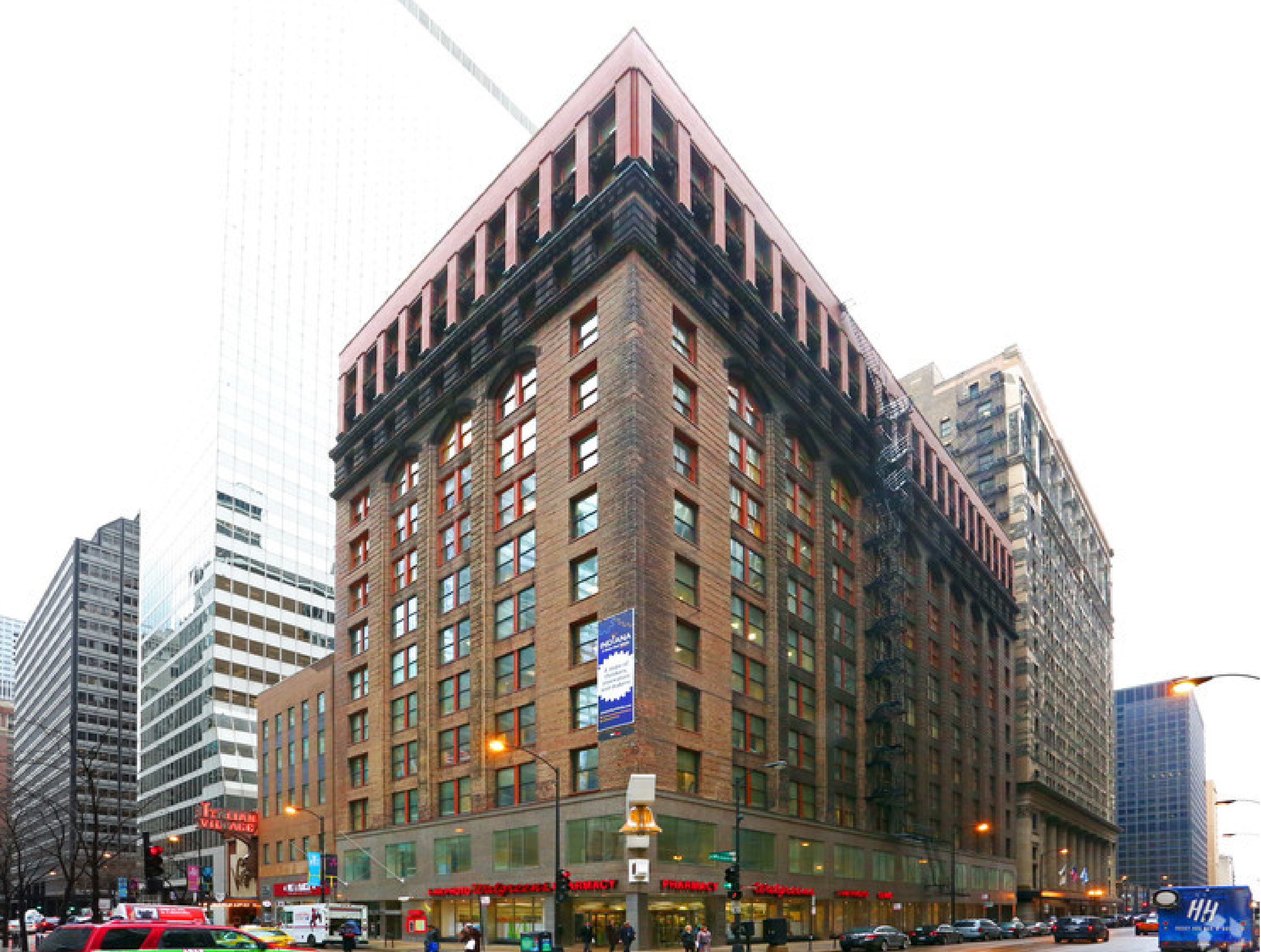On Wednesday, April 3rd, Mayor Brandon Johnson announced the selection of four developments for the LaSalle Street Reimagined initiative. These projects aim to rejuvenate the area by brining residents into the corridor after pandemic vacancies, utilizing $151.2 million in tax-increment financing funds. The office-to-residential developments will repurpose underused office buildings and add over 1,000 new residential units, including at least 319 affordable units. Pending approval by the City Council, completion is slated for 2027 as reported by WTTW News.
Listed below are the four developments that will be reviewed by City Council:

111 W Monroe St Image from Seven Can Plan
Prime Group aims to invest $203 million in constructing 345 apartments at 111 W. Monroe St, with 105 units designated as affordable. The development plan also includes a 228-room hotel. A $40 million subsidy has been requested for this project.

Exterior 208 S. LaSalle St. from Millennium Properties
At 208 S. LaSalle St, Prime Group also proposes $123 million to build 226 apartments, including 84 affordable units. The project has requested a $26.2 million subsidy.

Exterior 30 N. LaSalle from Stone Real Estate
Golub & Company intends to proposes $130 million at 30 N. LaSalle St to create 349 units, with 105 designated as affordable housing. The original proposal featured ground-floor retail, alongside green space. A $57 million subsidy has been requested for this project.

Image of 79 W Monroe Street via LoopNet
Campari Group’s proposal for 79 W. Monroe St involves $64.2 million to construct 117 apartments, including 41 affordable units. Additionally, the project aims to restore the iconic “Weather Bell” sign that indicates temperature changes. A $28 million subsidy has been requested.
Subscribe to YIMBY’s daily e-mail
Follow YIMBYgram for real-time photo updates
Like YIMBY on Facebook
Follow YIMBY’s Twitter for the latest in YIMBYnews


I cannot think of a worse Mayoral administration for this to happen under. I can already imagine the arm-twisting of the developers going on behind the scenes
……and not the good kind of arm twisting
This was ambitious from conception and I also question the current Mayor on having “the game” to get this done successfully. I am in favor of more residential development in the loop, but what about filling in some of the vacant lots just waiting for a project.
I agree. That office space might be needed in the future. I would prefer to raze the parking garages and build apartment buildings on that land.
We have SO much unused office space, I doubt it’ll ever all be needed again. Any we continue to build more office space anyway. The Loop as a CBD needs to die and be reborn as a Manhattan-like skyscraper neighborhood of plenty of mixed uses (including offices).
I’m glad this is moving forward. This will help spur residential development in the Loop and it will begin to establish institutional knowledge of office to residential conversions in the city for everyone involved, from government to the developers, contractors and financiers. Once we have that, the next round of conversions should be easier to accomplish. Unfortunately, financing is still tight for new development anywhere. I’m sure there is still a bit of skittishness as to financing residential development in the Loop without a clear picture as to its future.
financing tight everywhere? No, just Chicago. Other cities are booming with development. The leaders letting crime flourish and increasing taxes wont attract demand.
If that dense, Chicago continues to barely break the top 20 most dangerous cities in the US. If you weren’t a fool, you’d know these past four years have been brutal on tall development. Atlanta, Los Angeles, New York, Nashville, Boston, Seattle, Minneapolis, etc., have all had construction costs and inflation hardships.
Booming? Miami and New York are the only cities to see significant development; one of the 2 is Hurricane Central. The other is sinking, and both will experience catastrophic flooding throughout the current century.
Every week, this website has an array of development updates and new stuff approved and proposed, but the doomers love B*tching with their head in the sand…
Well said Drew, it’s good to bring facts back into the conversation instead of doom and gloom.
Love it. Glad the mayor was finally able to push this through. It’s important to convert these buildings and start the process of filling our downtown. It’s expensive but if we want to preserve these buildings this is what it takes. Can’t wait to see the impact after this is done.
Chicago downtown loop is no Manhattan, for residential occupancies. The supporting businesses that everyday families and individuals need have not developed yet. No drug stores, no food shopping, no automotive/bicycle repair, no parks except Daley and Millenium but they’re for tourists, no schools, etc. The Loop was designed for business. Restaurants were for business meals and drinks and then the Loop shuts down after 9pm. Imagine two adults and a four year old living at LaSalle and Adams? It won’t work.
The Loop has more going on than a ton of downtowns in the nation. Yeah, River North is much more happening, but I have lived in the Loop in a hotel for work and found it extremely easy to navigate. Two adults with kids aren’t out after 9pm shopping anyway, nor has that really been a possibility anywhere I have lived, other than the suburbs or at a city Walgreens or bodega.
Let’s see if the mayor can successfully pull anything off.
When will we all understand – crime is crazy out here-These units will be empty other than criminals utilizing them-
The city needs to finally say- lock them up-then the loop area will flourish again.
So, let’s take a look at the numbers:
111 W. Monroe St,
TIF: $40,000,000
All Units: 345 for $115,942 in TIF money per unit
Subsidized Units: 105 for $380,952.38 in TIF money per unit
208 S. LaSalle St
TIF: $26,200,000
All Units: 226 for $115,929.20 in TIF money per unit
Subsidized Units: 84 for $311,904.76 in TIF money per unit
30 N. LaSalle St
TIF: $57,000,000
All Units: 349 for $163,323.78 in TIF money per unit
Subsidized Units: 105 for $542,857.14 in TIF money per unit
79 W. Monroe St
TIF: $28,000,000
All Units: 117 for $239,316.24 in TIF money per unit
Subsidized Units: 41 for $682,926.83 in TIF money per unit
BTW, who really is living in subsidized units? Are we really helping the truly deserving or underemployed college grads looking for a cheap place to live?
Correct. The public benefit to these heavily subsidized units is just about zero. It’s 100% private benefit to those who know or can figure out how to maneuver through getting a unit, and who are lucky enough to snag one. The public gets zero out of this, unless you think having a tiny number of slightly less. prosperous people residing in the loop is somehow a big plus.
The 60602 zip code only had two residents for many years – the Methodist pastor and wife who lived in the parsonage at 77 West Washington – I think they would agree this housing needs to be supported by grocery stores etc. I also agree a couple of small parks would be nice, that lot at Washington and Franklin has been empty for years – or the idea of tearing down a parking garage / repurposing a parking lot is good too.
As someone who currently works in the loop, I haven’t experienced crime and neither have my co-workers, there are a lot of people shopping, going to work, etc. However, I agree that night life opportunities are lopsided. Theaters are full, but there aren’t many restaurant / bar options – people mostly go to River North to go out.
I don’t think we should save the buildings for future office space, those offices were empty before Covid because the exchanges moved online and financial services with them. Overall, I think creating more residential in the loop is good, the probability that groceries and other services will fast follow is high.
Imagine you create a demand and all those vacant storefronts people love to complain about endlessly now have a purpose.
How are people so stuck in this mindset of “we must return to our past ways” when it’s overwhelmingly clear our society will never function like it once did. There will never be a demand for these old officer buildings to ever be office again. They’re outdated, hard to retrofit, and lack the necessities big money corporations want. The only thing going for them is location and the want of people is to live closer to downtown. So… turn them to residential, the needs of said people will open a new market of all sorts of new retail and services, and we fill a massive gap of city awkwardness.
Crime flourishes in that awkward liminal space of where no one is around and opportunity is most feasible. Majority of break-ins and robberies happen when the occupants are gone. The same goes for empty streets and if you are not new to the city, you’d know downtown is a dead zone of everything wt night.
Naperville suburbanites will complain about everything. Too many people at the German Market? It’s a hellhole. Not enough people shopping at stores no one else can afford? The city is crumbling. The sounds of pearl clutching are gonna make their own genre soon.